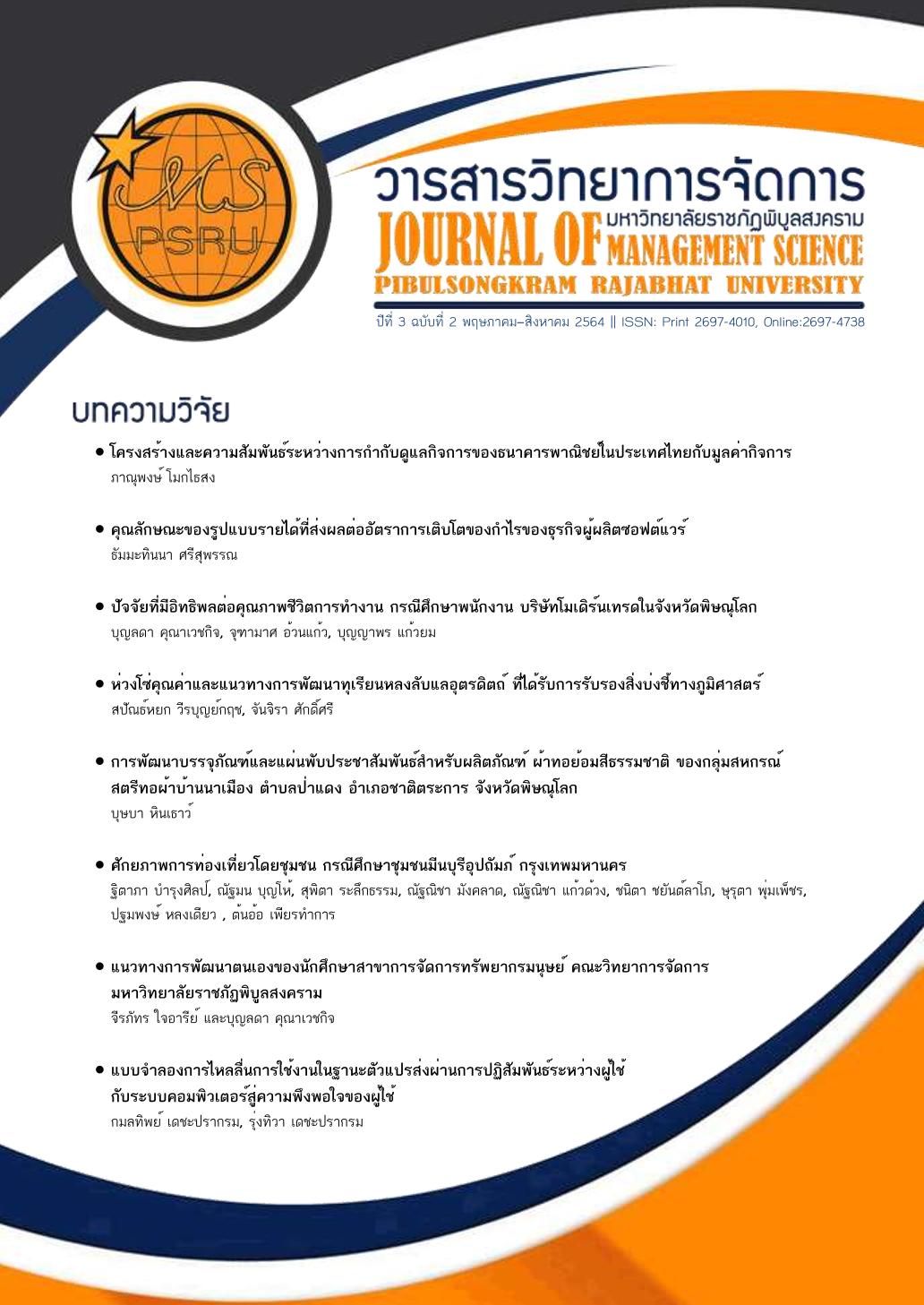Structural equation model of user control of flow as a full mediating effect between machine interactivity and user satisfaction
Keywords:
machine interactivity, user control of flow, user online satisfactionAbstract
The objective of this research is to examine the model of user online satisfaction which derives from the following factors: machine interactivity and user control of flow who bought products from social network business. The researchers applied the quantitative method to 599 customers who bought products from social network business and analyzed in term of structural equation model (SEM) analysis by AMOS.
The result revealed that 1) the model was consistent to the empirical data, Goodness of fit measures were found to be: Chi-square 32.932 (df=23, p=0.082); Relative Chi-square (c2/df) 1.432; Goodness of Fit Index (GFI) 0.988; Rood Mean Square Error of Approximation (RMSEA) 0.027; 2) In analyzing factors influencing user online satisfaction, it was found that two factored influence user online satisfaction in descending order of influence as following: user control pf flow (TE=0.668) and machine interactivity (TE=0.320) and all factors were predictive of user online satisfaction at 42.30 (R2=0.423) and 3) The influence of user control of flow as full mediating effect relationship between machine interactivity and user online satisfaction.
References
ประสิทธิชัย นรากรณ์. (2558). อิทธิพลของการไหลลื่น ความไว้วางใจในสมาชิก และการเผยแพร่ตัวตนในเครือข่ายสังคมออนไลน์ ในฐานะปัจจัยที่เชื่อมโยงการปฏิสัมพันธ์และความผูกพันของผู้ใช้สู่ผลการซื้อสินค้าออนไลน์ลัพธ์และความภักดีทางอิเล็กทรอนิกส์. กรุงเทพมหานคร: สำนักพิมพ์มหาวิทยาลัยรามคำแหง.
ประสิทธิชัย นรากรณ์. (2561). คุณภาพความสัมพันธ์และแรงสนับสนุนทางสังคมในฐานะตัวแปรเชื่อมโยงระหว่างโซเชียลคอมเมิร์ซกับความตั้งใจซื้ออย่างต่อเนื่อง. วารสารวิทยาการจัดการ มหาวิทยาลัยราช-ภัฏเชียงราย, 13(1), 44-69.
Baron, R. M. , & Kenny, D. A. (1986) . The moderator-mediator variable distinction in social psychological research: Conceptual, strategic and statistical considerations. Journal of Personality and Social Psychology, 51(6), 1173-1182.
Bentler, P.M. (1988), Theory and Implementation of EQS: A Structural Equations Program, Sage, Newbury Park, CA.
Browne, M.W. and Cudeck, R. (1993), Alternative Ways of Assessing Model Fit, Sage, Newbury Park, CA.
Chang, C. C. (2013). Examining users’ intention to continue using social network grams: A flow experience perspective. Telematics and Informatics, 30, 311-321.
Chen, K., Yen, D. C., Hung, S-Y., & Huang, A. H. (2008). An exploratory study of the selection of communication media: The relationship between flow and communication outcomes. Decision Support Systems, 45, 822-832.
Csikszentmihalyi, M. (1990). Flow: The psychology of optimal experience. Retrieved March 3, 2015, from http://scholar.google.co.th/scholar? q=FLOW
Ding, D. X., Hu, P. J-H., Verma, R., & Wardell, D. G. (2009). The impact of service system design and flow experience on customer satisfaction in on line financial services. Journal of Service Research Online first, 16, 1-16.
Dholakia, R. R., Zhao, M., Dholakia, R. R., & Fortin, D. (2001). Interactivity and revisit to websites: A theoretical framework. American Marketing Association, 12, 108-115.
Finneran, C. M., & Zhang, P. (2005). Flow in computer-mediated environments: Promises and challenges. Communication of the Association for Information Systems, 15(4), 81-102.
Fornell, C., & Larcher, D. (1981). Evaluating structural equation models with unobservable variables and measurement error. Journal of Marketing Research, 18(1), 39-50.
Hair, J.F., Black, W.C., Babin, B.J., & Anderson, R.E. (2010). Multivariate Data Analysis, 7th ed., Prentice-Hall, Upper Saddle River, NJ
Hoffman, D. L. & Novak, T. P. (1996). Marketing in Hypermedia Computer-Mediated Environments: Conceptual Foundations. The Journal of Marketing, 60(3), 1-36.
Hung, C-L., Chou, J. C-L., & Dong, T-P. (2011). Innovations and communication through innovation users: An exploratory mechanism of social networking website. International Journal of Information Management, 31, 317-326.
Jamshidi, D., Keshavarz, Y., & Mohammadian, M. (2017). Mobile banking behavior and flow experience : An integration of utilitarian features, hedonic features, and trust. International Journal of social economics, 45(1), 57-81.
Kim, J., Jin, B., & Swinney, J. L. (2009). The role of etail quality, e-satisfaction and e-trust in online loyalty development process. Journal of Retailing and Consumer Services, 16, 239-247.
Lee, T. (2005). The impact of perception of interactivity on customer trust and transaction intentions in mobile commerce. Journal of Electronic Commerce Research, 6(3), 165-180.
Liu, H. J., & Shiue, Y. C. (2014). Influence of Facebook game players’ behavior on flow and purchase intention. Social Behavior and Personality, 42(1), 125-134.
Noort, G. V., Voorveld, H. A. M, & Reijmersdal, E. A. V. (2012). Interactivity in brand web sites: Cognitive, Affecrive, and Behavioral Responses Explained by consumers’ online flow experience. Journal of Interactivity Marketing, 26, 223-234.
Novak, T. P., & Hoffman, D. L. (2000). Modeling the structure of the flow experience among web users, Retrieved October 6, 2021, from http://wiki.commres.org/pds/Project_7eNrf2010_2fPlan/Modeling%20the%20structure%20of%20the%20flow%20experience%20among%20Web%20users.pdf
Novak, T. P., Hoffman, D. L., & Yung, Y-F. (2000). Measuring the customer experience in online environments: A structural modeling approach. Marketing Science, 19(1), 22-42.
Nunnally, J. (1978). Psychometric Theory, New York: McGraw-Hill, NY.
Paek, B., Mores, A., Kim, M., & Jung, H. (2020). Sport consumer flow and shopping well-being in online shopping. International Journal of Sports Marketing and Sponsorship, 22(4), 721-736.
Papagiannidis, S., See-To, E., & Bourlakis, M. (2014). Virtual test-driving: The impact of simulated products on purchase intention. Journal of Retailing and Consumer Services, 21, 877-887.
Suntornpithug, N., & Khamalah, J. (2010). Machine and person interactivity: the driving forces behind influences on consumers’ willingness to purchase online. Journal of Electronic Commerce Research, 11(4), 299-325.
Wu, J-J., & Chang, Y-S. (2005). Towards understanding members’ interactivity, trust, and flow in online travel community. Industrial management & Data system, 105(7), 937-954.
Downloads
Published
How to Cite
Issue
Section
License
Copyright (c) 2021 Pibulsongkram Rajabhat University

This work is licensed under a Creative Commons Attribution-NonCommercial-NoDerivatives 4.0 International License.
บทความที่ได้รับการตีพิมพ์ในวารสารวิทยาการจัดการมหาวิทยาลัยราชภัฏพิบูลสงคราม เป็นลิขสิทธิ์ของมหาวิทยาลัยราชภัฎพิบูลสงคราม
บทความที่ลงพิมพ์ใน วารสารวิทยาการจัดการมหาวิทยาลัยราชภัฎพิบูลสงคราม ถือว่าเป็นความเห็นส่วนตัวของผู้เขียนคณะบรรณาธิการไม่จำเป็นต้องเห็นด้วย ผู้เขียนต้องรับผิดชอบต่อบทความของตนเอง



